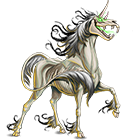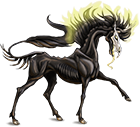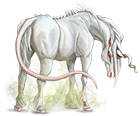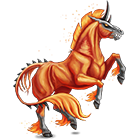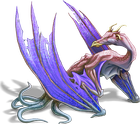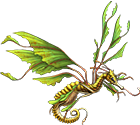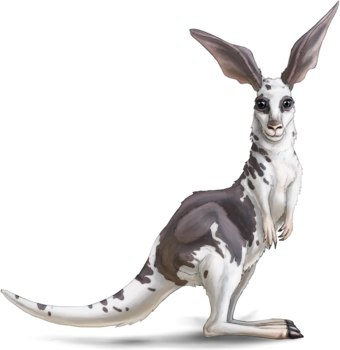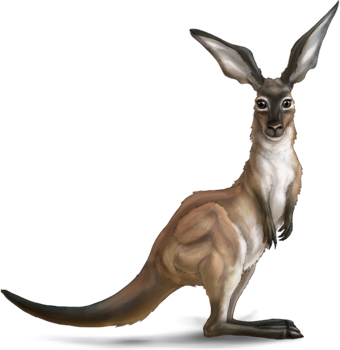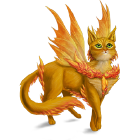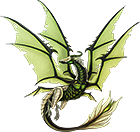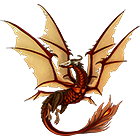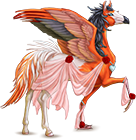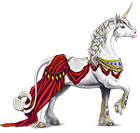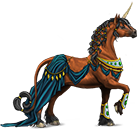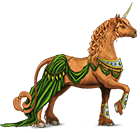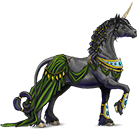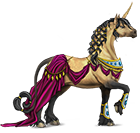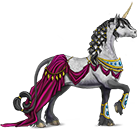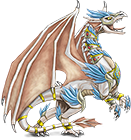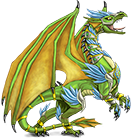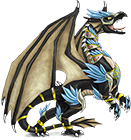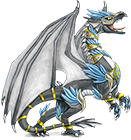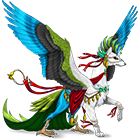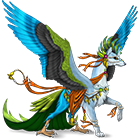Genetics
The genetics in this game work on the basis of Mendel's laws. Here's a rundown:
You know how the genes on your pets are separated in lines, and each line has 2 genes. Like the first line is the 2 genes for Jaws, next line for the 2 Senses genes, next is the line with the Brain genes and so on. Always, the gene on the left side is from the mother and the gene on the right from the father. When a breeding occurs, the game randomly picks one of those two genes to pass to the child.
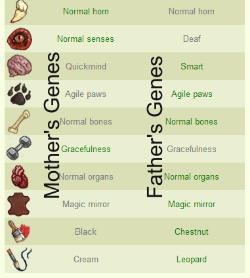
I will do an example which will hopefully make it clearer.. Let's take my pet Sure Fire (those are his genes in the picture up there) and look at his Brain genes (third line). To decide which genes he would have, the game looked at the mother's genes (Sure Fire's mother is True Legacy) and randomly selected one of her genes. She has Determined and Quickmind:

Both had an equal chance to be passed down to Sure Fire. So in this case, the game chose Quickmind and put it on the left (the mother's) side of Sure Fire's Brain genes.
Then the game looked at the father's genes and again randomly selected one of those two. In this case, Dune has Smart and Quickmind

The game chose Smart and put this on the right (the father's) side of Sure Fire's Brain genes.
So now Sure Fire has Quickmind on the left and Smart on the right side of his Brain genes:

To see what the possibilities are for a baby's outcome, you can do a Mendel's table, which means you put one parent's genes to the top, one parent's genes to the left and combine like this:
| |
|
Mother's Gene 1 |
Mother's Gene 2 |
| |
|
Determined |
Quickmind |
| Father's Gene 1 |
Smart |
Determined / Smart |
Quickmind / Smart |
| Father's Gene 2 |
Quickmind |
Determined / Quickmind |
Quickmind / Quickmind
|
See how Sure Fire is in this case the top right outcome (Quickmind / Smart) but there would have been three other possibilities as well?
Anyway, once the game has affixed the genes to the new pet, it will check the power of each gene to see which will be dominant (green) and which recessive (grey). You can see the power of each gene by hovering over it in a pet's Genetics tab or by checking in this list. In our case, Quickmind has a power of 50, while Smart has a power of 90. Since 90 is higher than 50, Smart is the dominant gene and Quickmind only recessive. What does that mean? Dominant means it is the "expressed" gene, the one that will be shown to the world , the one that actually does something for your pet's stats. Recessive genes are hidden. They don't do anything to the pet except that they can be passed down to offspring. In our example, Sure Fire has Smart and Quickmind. Smart increases the pet's Intelligence by 25%, Quickmind would increase it by 50%. Since Smart is dominant, Sure Fire's Intelligence is only increased by 25% (if you hover over his Intelligence, it says his basic value is 94, his genetics increase the stat by 24, which equals 25%).
Colours and Patterns
Colours and Patterns work the same way as the other genes.
In general you can say that the less power a colour has the harder it is to breed for (if you look at Unicorns again, Gray has the least power with only 40, so as soon as any other colour gene gets passed to the baby, Gray will only be recessive and not be shown). An easier chart to see this is the List of Skins. This is organized by Power already, so the colours/patterns at the top and to the left are the strong ones and the ones on the right / bottom are weaker and therefore the hardest to breed for. So again looking at Unicorns, the Silver Gray (made by having a Unicorn with Gray colour and Cream pattern gene) would be the rarest of the colours, while the White Uni the least rare (which is true, you will find the Pound cluttered with White Unicorns).
I will try my hand at another example. Because it's much easier, I will only do an example by colour. Pattern works the exact same way.
Let's say we want a Buckskin Unicorn. If we check the List of Skins we can see that this colouring is quite far to the bottom, meaning that a lot of other colours are more powerful - to be able to see thee colour though, we need the gene to be dominant (more powerful than the other gene, remember? :)). If our Uni had White, Bay, Chestnut or Black in its genes, we would see those and Buckskin would be hidden as recessive gene. Only Gray is less powerful than Buckskin.
So let's say you have a Uni in your Stable that has Chestnut / Gray in its genes. You would look through available studs and find one that has Buckskin double (hooray!).
Now when you breed those two, remember that it is completely random WHICH gene each parent gives to the baby. These are the chances for offspring:
| |
|
Mother's Gene 1 |
Mother's Gene 2 |
| |
|
Chestnut |
Gray |
| Father's Gene 1 |
Buckskin |
Chestnut / Buckskin |
Buckskin / Gray |
| Father's Gene 2 |
Buckskin |
Chestnut / Buckskin |
Buckskin / Gray |
As you can see, you might end up with a baby with Chestnut and Buckskin (in which case Chestnut would overpower Buckskin) or with a baby with Buckskin and Gray - and since Buckskin is more powerful than Gray, you would end up with a Buckskin Unicorn! Huzzah!
To spin this a bit further, let's say you ended up with a Chestnut / Buckskin baby. You could wait for it to grow up and then breed it to another Uni with double Buckskin gene. The possible outcome would look like this:
| |
|
Mother's Gene 1 |
Mother's Gene 2 |
| |
|
Chestnut |
Buckskin |
| Father's Gene 1 |
Buckskin |
Chestnut / Buckskin |
Buckskin / Buckskin |
| Father's Gene 2 |
Buckskin |
Chestnut / Buckskin |
Buckskin / Buckskin
|
So the possible outcomes are now Chestnut / Buckskin (in which case again, you wouldn't see the Buckskin colour) and Buckskin / Buckskin. To the naked eye, this looks the exact same as before, out of four babies 2 could look Chestnut and 2 Buckskin. However, now you actually have a chance to get a double Buckskin gene, which ties me to the following chapter - Deviants.
Deviant Colours
If you know how to breed for a specific colour, it's not too hard to breed for Deviants. First we have to know what Deviant Colours actually are. You could say, a Deviant is a mutation that occured when you bred your pets. Whenever you breed and the baby gets two of the same colour or pattern genes, there is a 10% chance for the baby to "mutate", to get the Deviant variant of the colour or pattern.
IMPORTANT NOTE: Deviant colours are NOT inheritable!
So first of all, you need to know the genes of the parents. If you can, select parents that both have the same colours or patterns to maximize the chance that the baby will get 2 of the same colour / pattern. Let's do another example, shall we?
Let's say I want to breed for a Gray Variant. I look through my stables for a female that has two Gray genes. This is actually the easiest variant to do, since we already know that Gray is the least powerful of all the colour genes.No matter which other colour might be in the genetic mix, the other colour would ALWAYS be stronger than Gray and overpower it. This means that if I see a pet with a gray colour, there can't possibly be another colour hidden as recessive. So, for my purposes, I select
Spot Me Some Blue. I then look some more for a male and find my
Romulus in my stables. I breed them together. Now I have a 10% chance that the baby will have the mutation, so I might have to rebreed the two of them a few times before I get what I want. And what do you know? The baby that came from this breeding is
Lilac Fantasy. When the baby is born it will look like any other gray baby,

you don't see which variant it will be, but you can tell by the little
asterisk (*) next to the Colour that this is in fact a deviant.
If you want to breed for a Pattern variant you will do this the same way. You select parents who preferably already have a double pattern gene, so it's guaranteed that the baby will get double pattern as well. It's then still a 10% chance that you get a baby with the mutation but if the parents only have one of the genes to begin with you lessen those chances even more! Someone who is better versed in math than I am may want to look over these figures, but if your parent pets only have your desired gene once, there's only a 25% chance to get a baby with the double gene and then only a 2,5% to actually get a deviant out of that breeding!
Now, you finally managed to breed for a deviant, but how do you know what it will actually look like?
Well, ideally you can
research the baby's genes. This means you either need to Research All in its genetics tab or have a Geneticist in your Inn so you can select to only research the colour/pattern genes. If you do this, you will see a yellow star next to the pattern or colour genes. This tells you where the mutation occured. Then you can go and
look at the Skin Library, scroll down and check in the apporpriate table. Let's take my
Lilac Fantasy as an example again (of course we already know what she looks like since she's grown up, but let's assume we don't know that yet). We know that her deivation occured in the Colour genes and that her colour is Blue Roan *. So in the Skin Library we scroll down to the table that says Deviant Color, Normal Pattern and look at Blue Roan, and voila! We know what the baby will look like grown up:
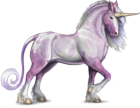
If we don't have the option to research the genes, we need to see if we can deduce anything from the parents' genetics. Let's do a hypothetical case with a baby pet that looks like this:
It says on his profile that he is a Bay Skewbald*. Checking his parents, we see that his mother looks like this:
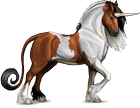
and his father like this:
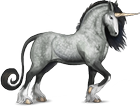
Can you tell which Deviation our baby has? This one is actually really quite simple. We don't need to know anything at all about the genes here! Both the baby and the mother are Bay coloured. We don't know what their recessive colour genes are. The father however is Gray. Since Gray is the least powerful gene, it's impossible that there is anything hidden, so the father must have given our baby one of his gray genes, which means that the baby can't possibly have double Bay! Therefore, we can easily see that his double genes (his deviation) must be in the Pattern. Let's take a look at the Skin LIbrary again, scroll down to where it says Normal Color, Deviant Pattern and look for Bay Skewbald. This is what the baby will look like:
Okay, now for the last part: Double Deviants!
To get a double deviant colouring, one parent must have a deviation in Colour and one parent in Pattern. If you breed those together, you have a CHANCE to get a double deviant. However, remember how I said deviation is not inheritable? That means when you breed the parents, you still need a deviation to occur on colour AND a deviation on pattern. Both of those only have a 10% chance to happen so that BOTH happen at once, the chances are only 1%... These are a rare treat!
For a while there was a bug that allowed you to breed any deviant colour with any deviant pattern pet but this has been fixed so now you actually need to breed fitting pets - it works exactly like normal deviant breeding just that you need to make sure that the baby will have double colour AND double pattern gene in the end.
So in order to get for example this one:
you would have to breed these parents

x
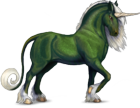
always making sure that both of them have double Black AND double Cream genes. Once you bred the two, maybe start praying a little, since as I said, chances are 1% - that means 1 in 100 breedings! (Of course, if you know percentages, this means it's entirely possible to get a double deviant on your first breeding, it just means that it is VERY unlikely; similarily you aren't guaranteed a double deviant even if you do breed 100 pets together, the chance is still the same)



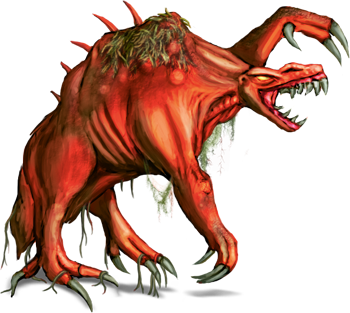







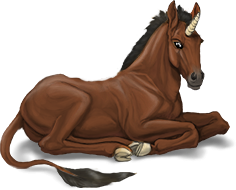
 and his father like this:
and his father like this: 
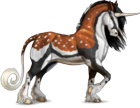
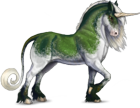
 x
x





